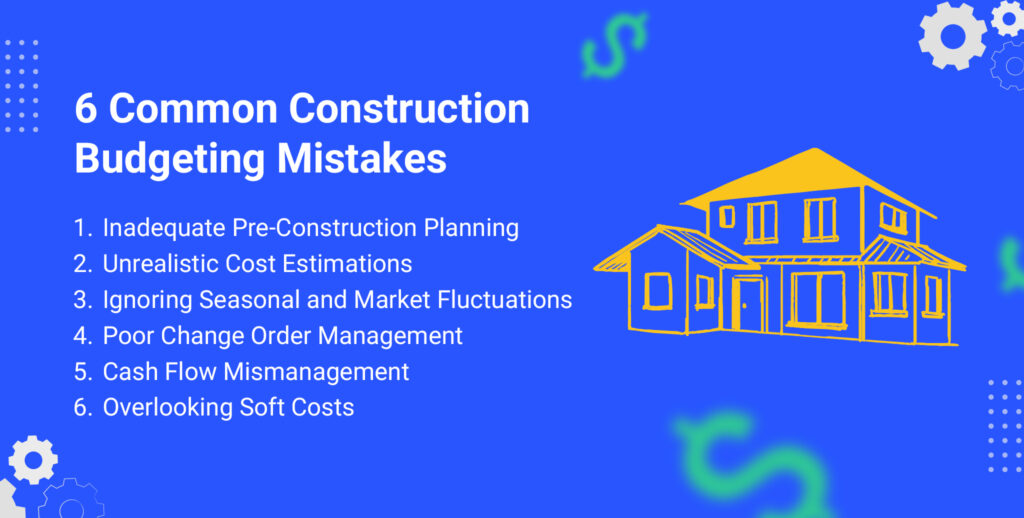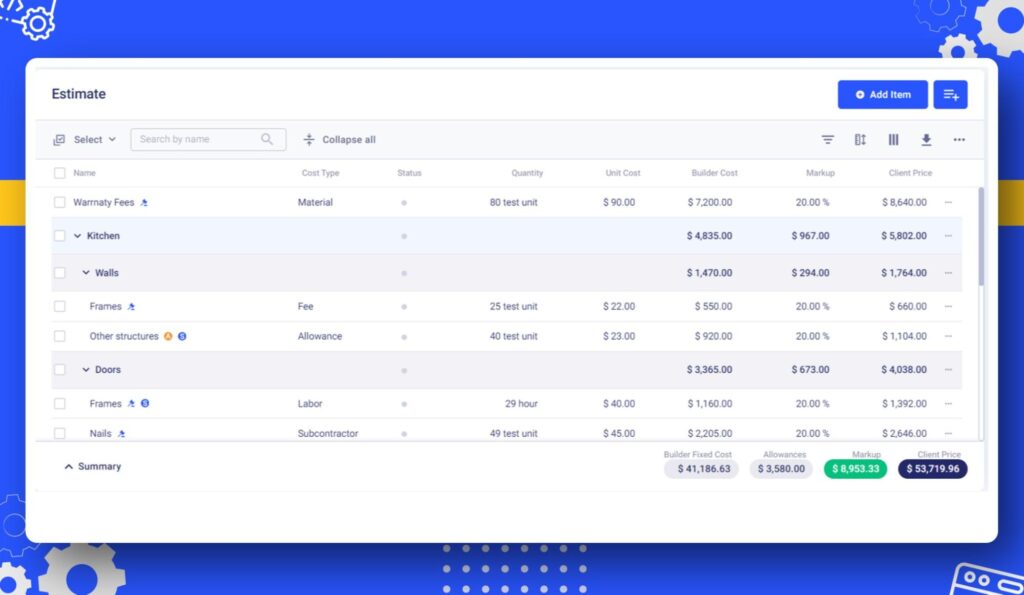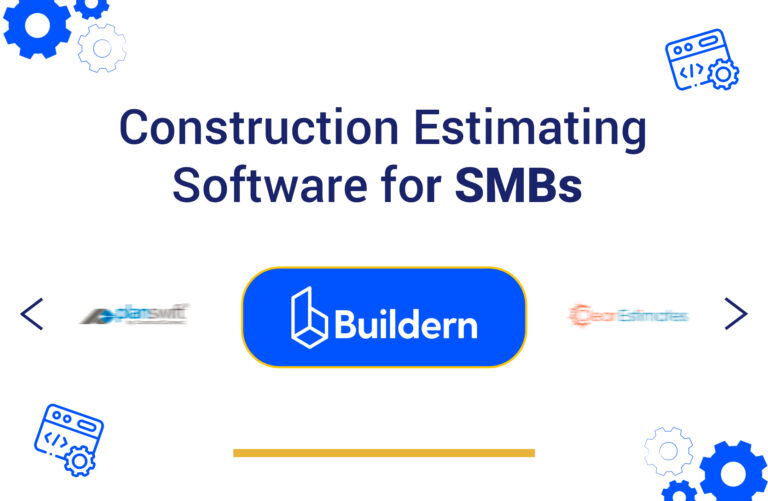6 Critical Construction Budgeting Mistakes to Avoid

Budgeting is one of the challenging parts of construction projects. It is estimated that 9 out of 10 construction projects experience budget overruns. It is so tricky that even the most seasoned professionals often make construction budgeting mistakes, which cause delays and, in worst-case scenarios, lead to project failure. These mistakes can stem from a wide range of sources, such as inaccurate cost estimation, lack of communication among all the stakeholders, or ineffective cash flow management. Understanding the most common budgeting mistakes in construction is the first step in avoiding them.
In this article, we will explore the top construction budgeting mistakes that contractors make and how to avoid them. Recognizing what types of mistakes there are, you can easily set the stage for more profitable construction projects.
Table of contents

The Importance of Accurate Budgeting
Construction budgeting isn’t just about numbers: it is the cornerstone of any construction project. Construction companies are destined to fail without an accurate construction budget due to unexpected delays and scope creep. A well-defined budget will allow you to plan everything accordingly, with an efficient resource allocation. Additionally, accurate budgeting allows you to prevent costly mistakes, as it forces you to think through your entire construction project. As a long-term consequence, you will be able to spot potential issues that might arise throughout your projects before they become costly mistakes.
6 Common Construction Budgeting Mistakes
Construction budgeting can be very tricky, requiring meticulous attention to every detail to avoid overruns. Unfortunately, it sometimes becomes difficult to control, and even the most skilled professionals make costly mistakes. Let’s explore the top construction budgeting mistakes and learn how to avoid them to ensure the financial stability of construction businesses.

Mistake 1: Inadequate Pre-construction Planning
While it is often overlooked, pre-construction is one of the most critical aspects of construction projects. Typical mistakes in preconstruction planning include incomplete site assessment, lack of feasibility studies, and poorly defined project scope.
🔍 The issue
Inadequate pre-construction project planning can result in:
Unrealistic Budget: If you do not dedicate enough time to your pre-construction project planning, your budget will not be based on accurate data, ultimately leading to an underestimation of your project costs.
Lack of project scope: If your construction project does not have a clearly defined project scope, you are likely to have frequent changes in your project, which can cause unforeseen costs in your change orders or unexpected delays.
Discrepancies in the schedule: A well-defined pre-construction project planning means having a project sequence. Without proper project planning in place, your construction project’s timeline may become unrealistic. This may cause delays and double the costs.
✅ How to Avoid It
Conduct a site survey and soil testing: Before moving further, it is essential to conduct a site survey and soil testing. This step will allow you to identify any issues at the construction site. You will know everything about building safety and potential causes of delays. As a result, you will be able to make an informed decision without any compromises.
Comprehensive design development: Before even rushing to budgeting, it is highly recommended to come up with an accurate design of your construction project. This will help you to make sure that all the project requirements are considered, and there will not be any costly changes in the future.
Assess the risk and come up with contingency plans: There are a wide variety of risks and safety issues that may arise throughout your construction project. Being informed about all the types of risks at the construction site and preparing a backup plan will ensure that everything will be handled accordingly in the future, without unexpected surprises.
Have a preliminary scheduling: While this is not something mandatory, having a preliminary scheduling is a wise step to take. This will ensure the smooth delivery and coordination of your tasks, minimizing the risks of miscommunications and downtime.

Mistake 2: Unrealistic Cost Estimation
Precise cost estimation is the heart of every construction project. Despite this, unrealistic cost estimation remains one of the most common budgeting mistakes in construction. Even small miscalculations at the start can compound into major financial gaps as the project advances.
🔍 The Issue
Inaccurate cost estimation can result in:
- Underestimated Budget: If your project’s cost estimations rely on assumptions or incomplete data, rather than on accurate information, you are likely to have underestimated costs for your labor, materials, or equipment. As a long-term consequence, this may lead to budget overruns, ultimately leading to project delays, or in worst-case scenarios, project termination.
- Unanticipated Cost Overruns: When making your cost estimation, make sure to consider market fluctuations, site-specific conditions, as well as soft costs. If you avoid these important steps, your project’s actual costs may start to spiral, leading to funding gaps.
- Inadequate Contingency Planning: Without accurate cost estimating, usually, there is little or no money to cover unforeseen issues such as weather-related delays or labor shortages. As a result, project managers may make snap decisions that affect the scope and the quality of construction projects negatively.
✅ How to Avoid It
- Use Real-Time Data: When making your estimates, make sure to review your data from similar projects you have done before. Additionally, ensure that you are informed about the current market fluctuations.
- Build in Contingencies: Allocate a specific budget to your contingencies. This will allow you to accommodate for unexpected issues without derailing the entire project.
- Conduct Detailed Scoping and Planning: Invest your time in identifying the scope of your project. Clearly define the scope of your project and plan everything in detail. This will help you guarantee that you have not skipped any hidden costs.
- Utilize a Construction Estimating Software: Using an advanced construction estimating software will help you in accurate project planning. Such software as Buildern helps you create estimates that will form a solid framework for your proposal and bidding processes.

Mistake 3: Ignoring Seasonal and Market Fluctuations
Seasonal trends and market dynamics play an important role in construction. Depending on seasonal and market conditions, prices for materials and labor can shift significantly. Ignoring these fluctuations can throw off even the most well-planned budgets.
🔍 The Issue
Ignoring seasonal and market fluctuations is one of the leading causes of budget mismanagement. Very often, initial project estimates rely heavily on hard costs, such as materials and labor, overlooking the importance of external factors like seasonal and market fluctuations.
Without understanding the seasonal and market fluctuations, your construction project is destined for the following:
Budget Overrun: Due to seasonal demand and market conditions, the costs of materials and labor can fluctuate and often increase. If you ignore seasonal and market fluctuations, you likely will have an inaccurate estimate, and as a result, might have a budget overrun.
Weather-Related Delays: It is essential to consider weather conditions when planning construction. Seasonal weather changes can impact the construction schedule and cost. For example, winter conditions can halt outdoor work for weeks, requiring expensive temporary heating or accelerated schedules to make up lost time.
Supply Chain Disruptions: Ignoring season and market fluctuations can lead to supply chain disruptions, which can cause delays in material delivery and increase material costs. In construction projects, when materials are not delivered to the labor on time, it can cause budget overruns, affecting the entire project timeline.
✅ How to Avoid It
Conduct a Comprehensive Market Research: Before starting your construction project, conduct a thorough research, and try to understand historical price trends in the specific location. Additionally, make sure to plan your project schedule around a predictable seasonal pattern. This will allow you to avoid peak pricing periods and budget overruns.
Build a Strong Supplier Relationship and Maintain Backup Suppliers: Establish partnerships with multiple reliable suppliers and build a strong supplier relationship with them. Make sure to have your materials in advance to avoid project delays. Additionally, it is highly recommended to maintain a backup supplier that will allow you to collaborate with them if something goes wrong with your first supplier.
Come Up with a Flexible Project Scheduling: Make sure that the tentative but realistic project schedule where you have considered seasonal fluctuations. It will be wise to plan indoor work during adverse weather conditions. This will allow you to stay productive and keep up with the project schedule.
Mistake 4: Poor Change Order Management
Change orders are an important constituent of construction projects. Yet, in some cases, it is one of the most mismanaged features of budgeting. When not handled properly, poor change order management can negatively affect the financial health of your business. Very often, construction companies do not establish clear processes for documenting, approving, or pricing change orders, which ultimately leads to financial problems.

🔍 The Issue
Poorly managed change orders to lead to the following issues:
Budget Overrun: In construction, when change orders are not handled properly, projects are destined to exceed their budget. Without standardized protocols in place, the chances of underestimating the real cost of changes are very high, which can result in budget overruns.
Project Delays: Poorly managed change orders can cause havoc on project schedules. Usually, when changes require materials or labor that are not scheduled, it can push project completion dates back for a few weeks, and even months.
Lack of Quality Control: When change orders are not managed properly, this can lead to rushed change implementations. As a result, project managers can make hasty decisions that negatively affect the quality of work. This, unfortunately, can ultimately lead to an expensive rework cycle.
✅ How to Avoid It
Establish a Formal Change Order Process: Create a standardized, written process that every team member understands and follows without exception. This process should clearly define what constitutes a change, who has the authority to approve changes, and the required documentation for each step.
Implement Written Documentation Requirements: Never allow work to begin on any change without written authorization. Establish forms and templates that capture all essential information: scope description, cost estimate, timeline impact, and client approval signature. This will help you to ensure that everyone is on the same page.
Utilize Construction Software: Using advanced construction software can make things so much easier for you. It will allow you to easily record and track any changes to the contracted scope of work while also allowing you to adjust your budget, schedules, material, or labor costs.
Mistake 5: Cash Flow Mismanagement
Cash flow is the lifeblood of construction projects. When not handled properly, cash flow mismanagement can threaten the survival of your construction business. Very often, construction companies fail to establish proper cash flow forecasting or payment tracking, which ultimately leads to financial crises.
🔍 The Issue
Poorly managed cash flow leads to the following issues:
Labor or Material Shortage: In construction, when cash flow is not monitored properly, companies struggle to meet their immediate financial obligations. Without proper forecasting protocols in place, the chances of running out of working capital are very high, which can result in project shutdowns and business failure.
Delayed Payments to Subcontractors: Poorly managed cash flow can cause serious strain on vendor relationships. Usually, when payments to subcontractors and suppliers are delayed due to cash shortages, it can damage critical business relationships and increase costs for future projects.
Project Financing Issues: When cash flow is not managed properly, this can lead to emergency borrowing at unfavorable terms. As a result, project managers may be forced to seek expensive short-term financing that negatively affects project profitability. This, unfortunately, can ultimately lead to reduced profit margins and financial stress.
✅How to Avoid It
Establish Regular Cash Flow Forecasting: Create a standardized forecasting process that every project manager understands and follows without exception. This process should clearly define payment schedules, expense timing, and cash requirements for each project phase, with regular updates to maintain accuracy.
Implement Payment Tracking Systems: Never allow invoices to go unmonitored after submission. Establish systems and templates that capture all essential information: invoice dates, payment terms, follow-up schedules, and collection status. This will help you to ensure that everyone is on the same page.
Set a Clear Payment Schedule: Having a transparent payment schedule with all your stakeholders is fundamental for your cash flow. Make sure to have milestone-based payment terms, since in most cases, construction projects involve multiple phases. This proactive approach will allow you to maintain positive cash flow and mitigate the risk of project delays.
Mistake 6: Overlooking Soft Costs
Construction soft cost is an important constituent of construction projects. Yet, in many cases, during estimation, many contractors overlook the soft costs, without recognizing that soft costs are as important as hard costs. Miscalculating soft costs even by a small margin can significantly affect the financial standing of your business.

🔍 The Issue
Overlooking or miscalculating soft costs can lead to:
Budget Overruns: When soft costs, like permits, insurance, and other administrative fees, are left out of the initial budget, they can easily drive the total spending beyond its estimated budget, leading to budget overruns.
Delayed Project Start: Construction soft costs are important for keeping construction projects on schedule. Overlooking these costs can result in unexpected delays that stall progress before or during construction.
Reduced Project Scope or Quality: Overlooking soft costs may result in reduced project scope and quality. When soft costs are not considered properly beforehand, construction project managers may make hasty decisions that can negatively affect project scope and quality.
Suggested Reading
Construction Soft Costs: Overview, Types, and Best Practices for Managing Them
✅ How to Avoid It
Formulate Clear Contracts: Contract formulation is one of the most important parts of a construction project. Make sure to formulate one in your construction project to ensure all types of construction soft costs are considered.
Hire Skilled and Experienced Professionals: Having skilled and experienced professionals is essential since they will help you come up with an accurate estimate. Based on their previous experiences, they might anticipate challenges as well as costs that were not evident during the preconstruction phase of the project.
Have a Contingency Plan: It is highly recommended to allocate a certain percentage of your budget to known expenses. This will ensure that everything runs smoothly without project delays or budget overruns.
Final Thoughts
Construction budgeting mistakes can transform profitable construction projects into financial disasters. These issues don’t exist in isolation, and they can create cascading effects that threaten your business’s survival. The good news is that most budgeting mistakes are entirely preventable with proper planning, clear processes, and the right tools.By recognizing common pitfalls early, you can take proactive steps to protect your budget, timeline, and long-term project success.



